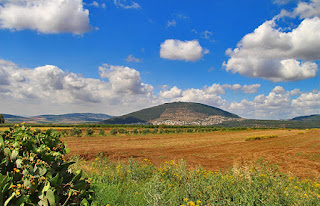Today's Feast of the Transfiguration of the Lord takes precedence over the normal Sunday liturgy—it being a feast of the Lord Jesus Christ. Each of the three synoptic Gospels—Matthew, Mark and Luke—contain an account of the Transfuguration; we heard Matthew's this morning. I believe it was St. Augustine who first analyzed Matthew's gospel using the mountains that loom large in the narrative: first, the mountain of the Beatitudes with its sublime spiritual and ethical teaching contained in Jesus' Sermon on the Mount, second, the mountain of the Transfirguration (generally thought to be Mt. Tabor), and, third, the mountain or hill of Calvary. Each mountain can be thought of as representing an important aspect of the Gospel of Christ, and every aspect of Gospel life is mystical. Without Christ we can do nothing, but through, with and in Christ we can do all things.
Thus, the ethical teaching of the Sermon on the Mount can only be truly practiced by people who live for Christ and in Christ. The redeeming co- suffering of Christians that Christ witnessed as the primal example on Calvary is only efficacious when one has identified with Christ in this most radical way—suffering with and in Christ. Yes, Christ tells us, “Without me you can do nothing.” But St. Paul also tells us , “I have the strength for everything through him (that is, Jesus Christ) who empowers me.” Christianity is an essentially mystical way of life, and Mt. Tabor, the site of the Transfiguration of Jesus is an essentially mystical mountain not only for Jesus and Peter, James and John, but for all of us disciples as well.
All three of the Gospel accounts of the Transfiguration follow on the announcement by Jesus of his first prediction of his passion, death and resurrection. Luke alone tells us that they went up Mt. Tabor to pray, but we must remember that the people of Jesus' time looked upon mountains as the usual sites for revelations of God—as many people still do today. The structural purpose of the Transfiguration seems to be to give to the disciples (including us) a needed spiritual uplift in the face of impending challenge and suffering. That uplift is for us, as St. Luke tells us in his version, prayer. We should think not only of private prayer, but liturgical, sacramental prayer as well, prayer that will foster our progress toward intimate union with Christ—mystical prayer.
A beautiful passage in the Catechism of the Catholic Church describes the intense contemplative prayer of a simple parishioner of the Cure of Ars. The passage uses the same concepts and vocabulary as the Gospel description of the Transfiguration. “Contemplative prayer is the pre-eminently intense time of prayer. Contemplation is a gaze of faith, fixed on Jesus. 'I look at him and he looks at me' said the peasant of Ars. This focus on Jesus is a renunciation of self. His gaze purifies our heart; the light of the countenance of Jesus illumines the eyes of our heart and teaches us to see everything in the light of his truth and his compassion for all people... Contemplative prayer is hearing the Word of God, is the obedicnce of faith.” In the Gospel today and everyday we disciples are captivated by the transfigured face of Jesus, the beloved Son of the Father, the face which shines in our hearts like the sun, and we listen to his word as we make our obedience of faith. “This is my beloved Son in whom I am well pleased. Listen to him.”
Furthermore, the Church teaches in the Catechism that as Jesus' baptism proclaimed the mystery of the first regeneration which is our baptism, the Transfiguration is “the sacrament of the second regeneration: our own Resurrection. From now on we share in the Lord's Resurrection through the Spirit who acts in the sacraments of the Body of Christ. The Transfiguration gives us a foretaste of Christ's glorious coming when he will 'change our lowly body to be like his glorious body.'” The Eucharist we are about to receive not only changes bread and wine into the body and blood, soul and divinity of Christ, but in receiving it in faith, hope and love we are also given a foretaste of our transfiguration, our being lifted up into resurrection and glory. The grace and strength are given to us to climb the three mountains: first, that of the Beatitudes and the Sermon on the Mount, second, that of the Transfiguration and, finally, our own Calvary—death and transfiguration.

